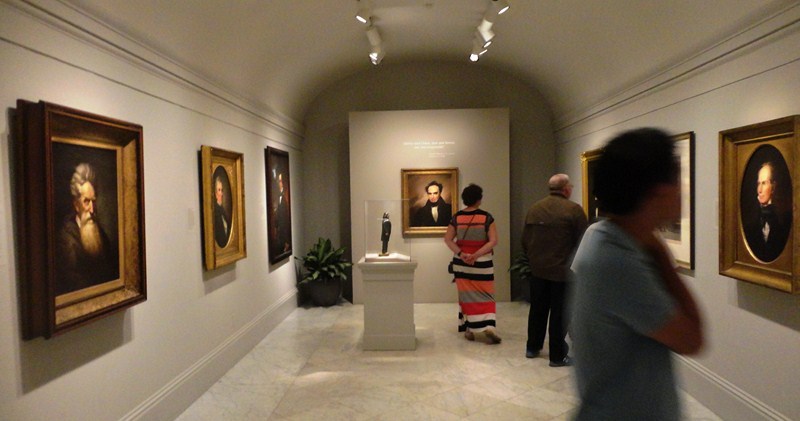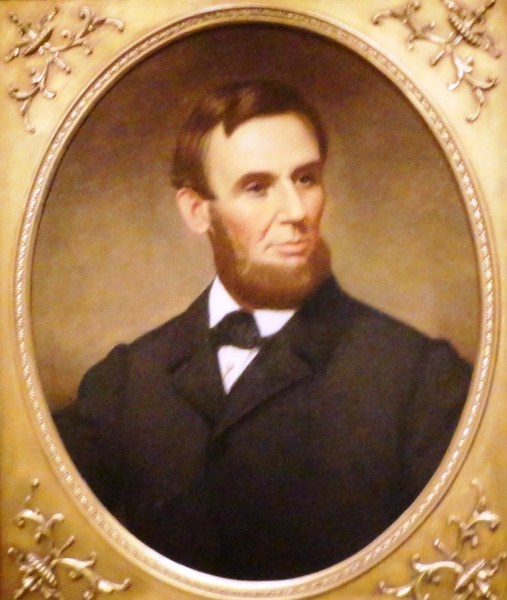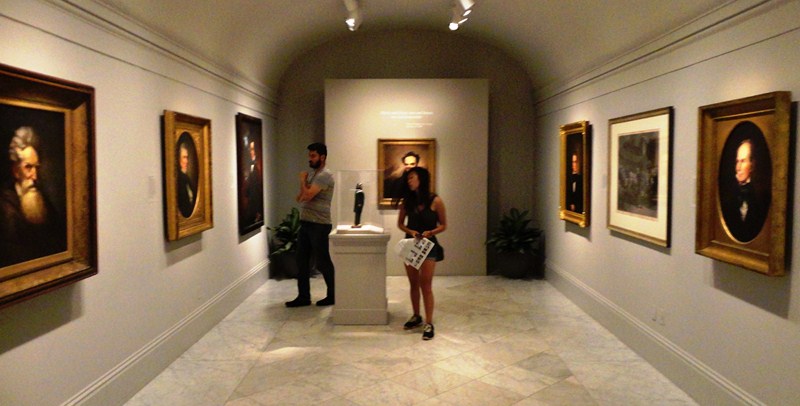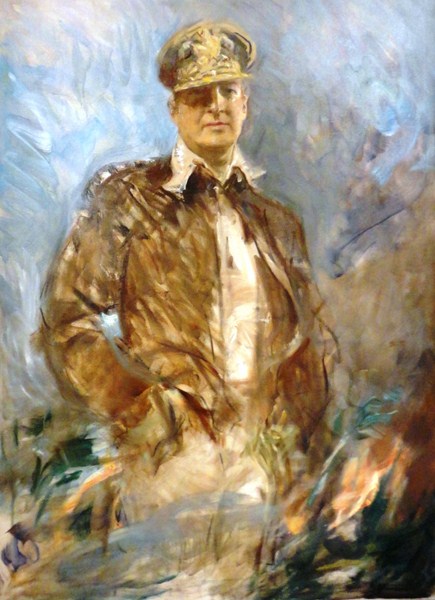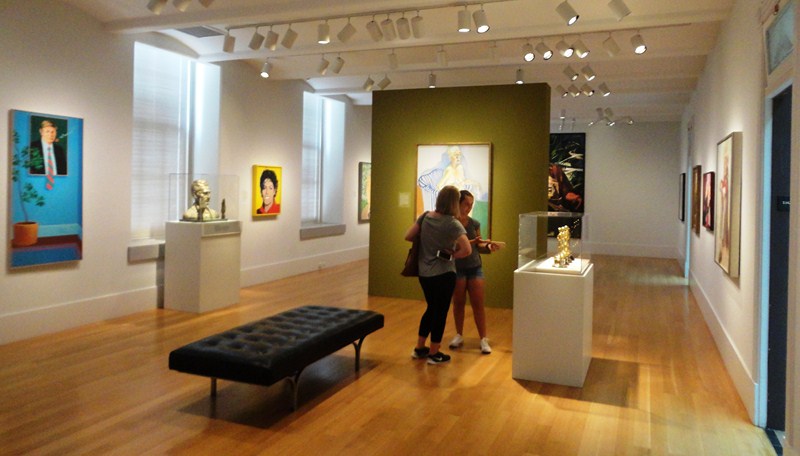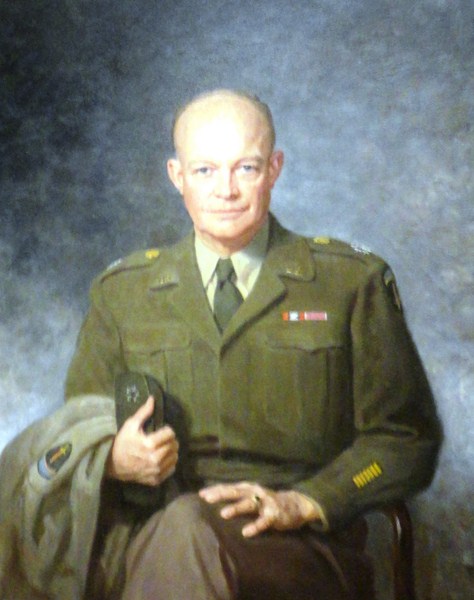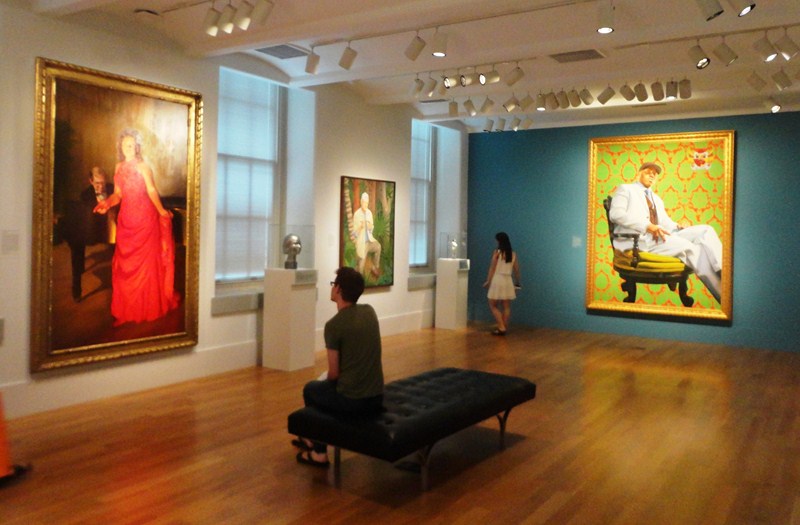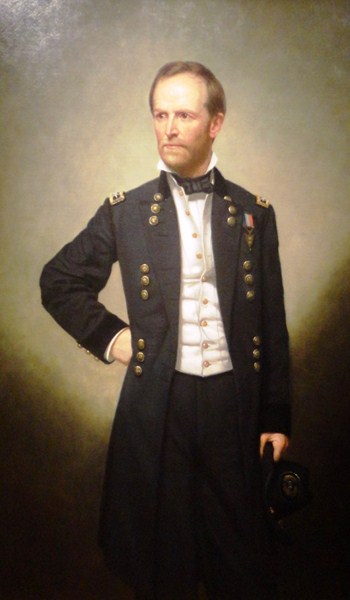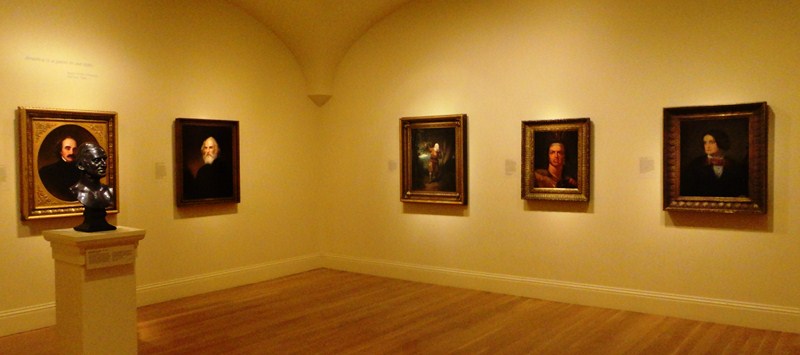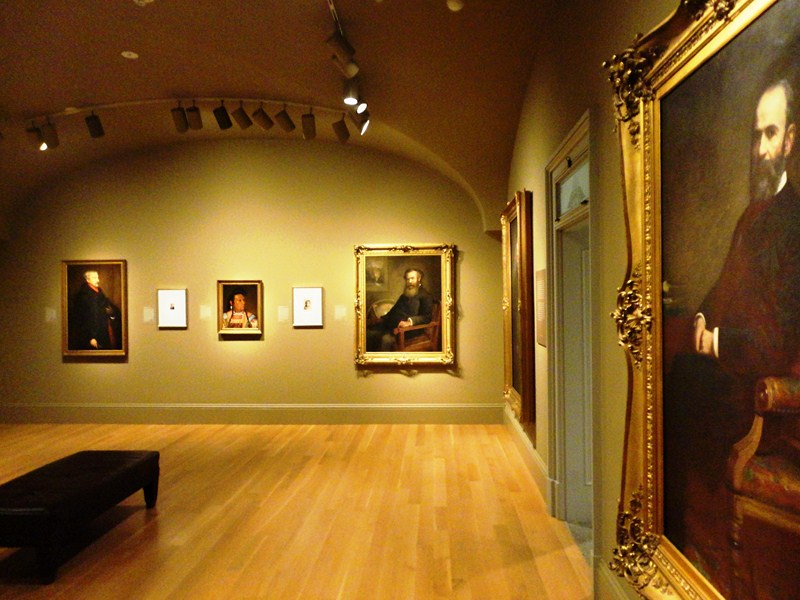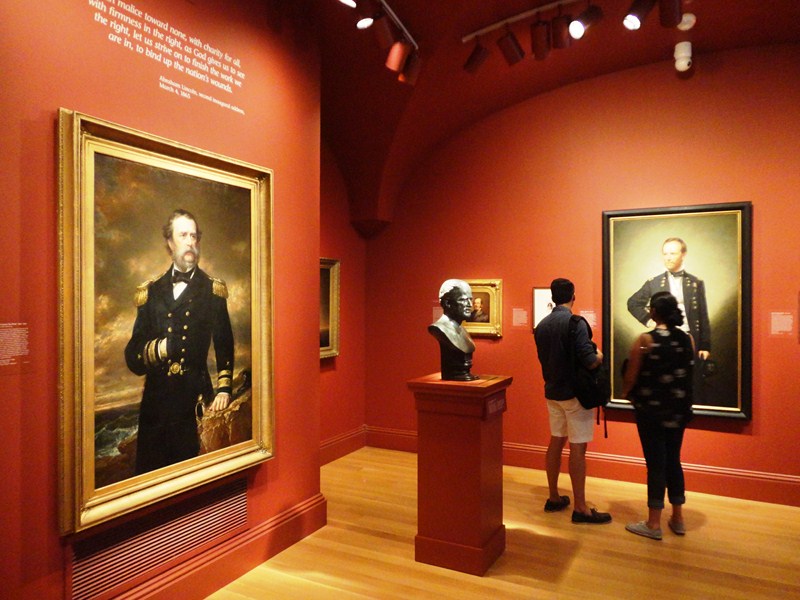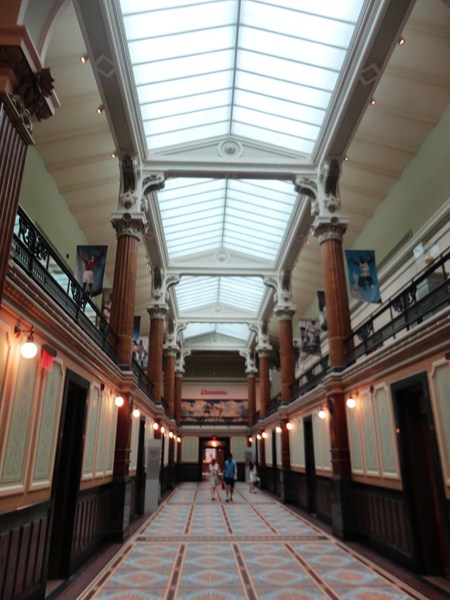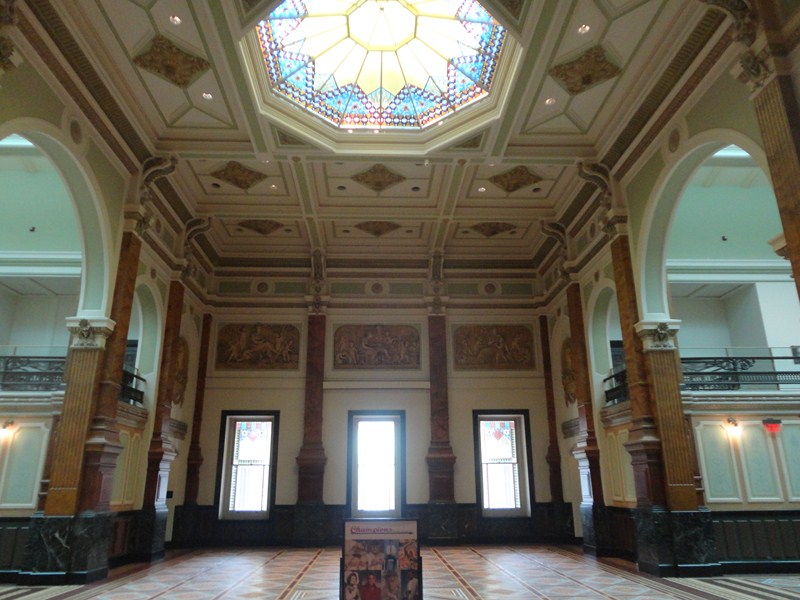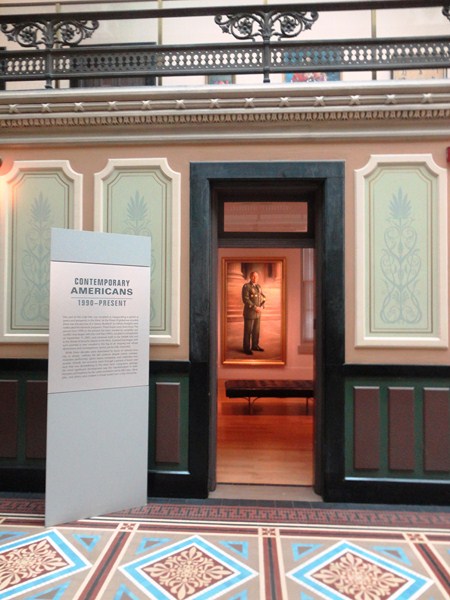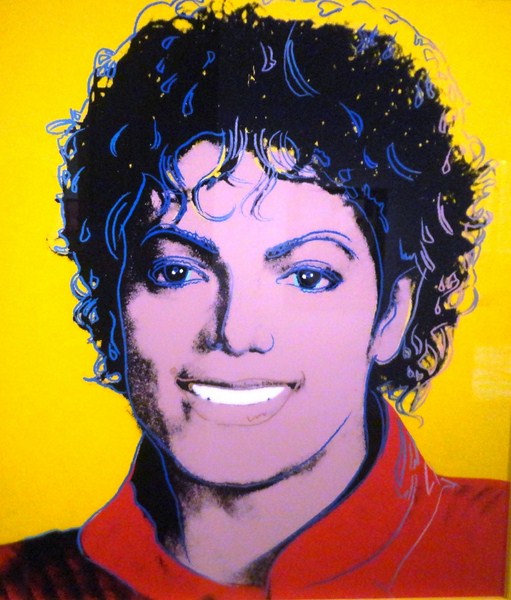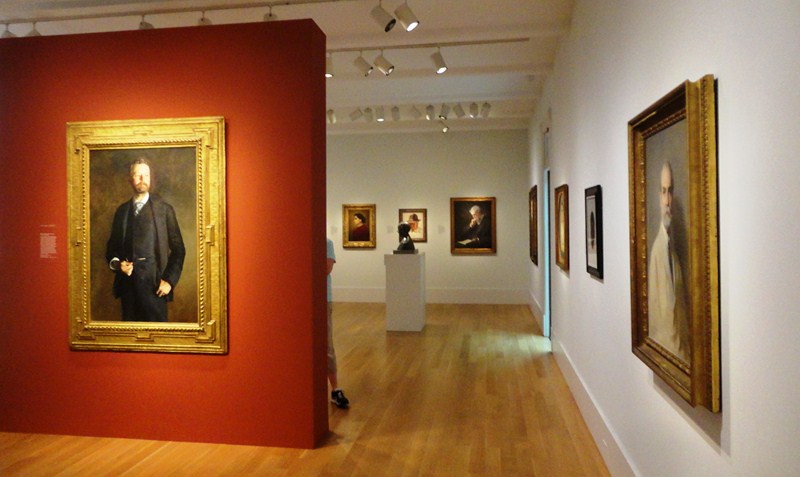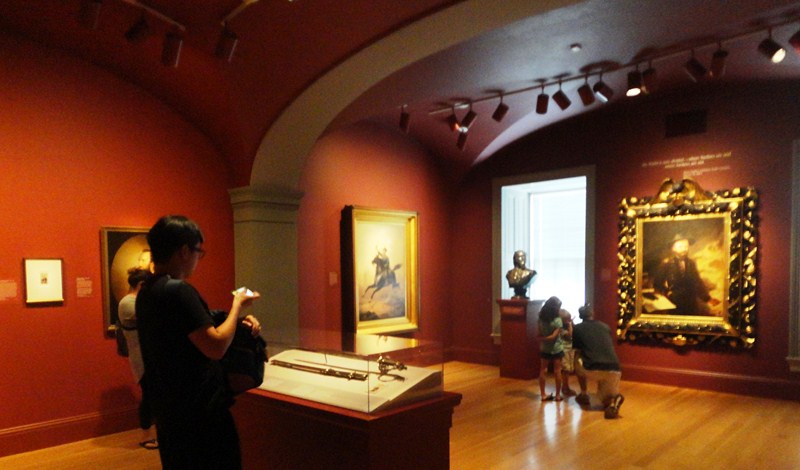The National Portrait Gallery, a historic art museum housed in the historic Old Patent Office Building (as is the Smithsonian American Art Museum), now the Donald W. Reynolds Center for American Art and Portraiture, is part of the Smithsonian Institution.
Today, the National Portrait Gallery continues to narrate the multi-faceted and ever-changing story of America through the individuals who have shaped its culture and, through the visual arts, performing arts and new media, it presents poets and presidents, visionaries and villains, actors and activists whose lives form our national identity.
Check out “Donald W. Reynolds Center for American Art and Portraiture” and “Donald W. Reynolds Center for American Art and Portraiture – Smithsonian American Art Museum”
Initially restricted to paintings, prints, drawings, and engravings, the collections, over the years, have grown from more than 2,000 items 1981 and, in 1990, the number of images in the museum’s photography collection reached 8,500 objects. As of 2011, the National Portrait Gallery was the only museum in the United States dedicated solely to portraiture.
In 2013, the museum had 65 employees and an annual budget of $9 million. February 2013, it housed 21,200 works of art, which had been seen 1,069,932 visitors in 2012. Today, the NPG collection of over 23,000 items, in all media, from daguerreotypes to digital, had grown so large that the exhibit drew its images almost entirely from the museum’s own collection.
The Hall of Presidents, a hallmark of the NPG’s permanent collection, is the largest and most complete collection in the world, except for the White House collection itself. Containing portraits of nearly all American presidents, the centerpiece of the Hall of Presidents is the famous Lansdowne portrait of George Washington. How the museum obtains presidential images has changed over the years.
From 1962 to 1987, presidential portraits were usually obtained through purchase or donation but, beginning in 1998, NPG began commissioning portraits of presidents, starting with George H. W. Bush, for its “America’s Presidents” exhibition (Gilbert Stuart’s Lansdowne portrait of George Washington is the grand introductory image to this exhibition). In 2000, NPG began commissioning portraits of First Ladies as well, beginning with Hillary Clinton.
Funds for these commissions are privately raised, and each portrait costs about $150,000 to $200,000. It still continues to acquire portraits (including paintings, sculpture, photographs, caricatures, video, and time-based media) of each succeeding president.
The NPG hosts the prestigious Outwin Boochever Portrait Competition, a triennial, juried contemporary portrait exhibition widely regarded as the most prestigious portrait competition in the United States. It also brings commissioned works into the collection. Artists working in the fields of painting, drawing, sculpture, photography, and other media are allowed to enter.
Works must be created through a face-to-face encounter with the subject. The winner of this inaugural competition was David Lenz of Milwaukee, Wisconsin. He was commissioned to paint a portrait of Eunice Kennedy Shriver (the founder of the Special Olympics), the first portrait commissioned of an individual who has not served as a President or First Lady.

On the left is a portrait of Stephen Van Rensselaer III (John Wesley Jarvis, 1825-35) while on the right is a portrait of Antonia Pantoja (Manny Vega, marble, glass and stone, 2014)
Dave Woody of Fort Collins, Colorado, the 2009 winner, was commissioned to photograph food pioneer Alice Waters, founder of the Chez Panisse Restaurant and Cafe, the Edible Schoolyard and champion of the Slow Food movement.
During the 2013 competition, the total prize money of $42,000 was awarded to the top eight commended artists, and the winner received $25,000 and a commission to make a portrait for the museum’s permanent collection. The artist and the NPG curators jointly decided the subject of the commission. The 2013 winner was Bo Gehring of Beacon, New York, who was commissioned to direct a close-up video and sound portrait of jazz musician Esperanza Spalding which drew delight and praise from visitors.
Here is the historical timeline of the gallery:
- In 1962, the National Portrait Gallery was authorized and founded Congress with the mission to acquire and display portraits of individuals who have made significant contributions to the history, development, and culture of the people of the United States.
- In 1965 (the bicentennial of James Smithson‘s birth), “Nucleus for a National Collection,” the first NPG exhibit, went on display in the Arts and Industries Building.
- In 1966, the NPG completed the Catalog of American Portraits, the first inventory of portraiture held the Smithsonian. The catalog also documented the physical characteristics of each artwork, and its provenance (author, date, ownership, etc.). That same year, the museum moved into the Old Patent Office Building with the National Fine Arts Collection.
- In 1968, Gilbert Stuart’s 2.4 5 m. (8 5 ft.) Lansdowne portrait (commissioned in April 1796 Senator William Bingham of Pennsylvania—one of the wealthiest men in America at the time) of George Washington was exhibited the National Portrait Gallery, and it remained there on indefinite loan.
- In 1969, the Old Patent Office Building was renovated the architectural firm of Faulkner, Fryer and Vanderpool.
- In 1971, the NPG began the National Portrait Survey, an attempt to catalog and photograph all portraits in all formats held every public and private collection and museum in the country.
- On July 4, 1973, “The Black Presence in the Era of the American Revolution, 1770–1800,” the first exhibit at the museum dedicated solely to African Americans, was opened the NPG.
- In 1974, Philanthropist Paul Mellon donated 761 portraits French-American engraver B.J.F. de Saint-Mémin to the museum.
- In January 1976, Congress passed legislation allowing the NPG to collect portraits in media other than graphic arts, permitting the NPG to begin collecting photographs.
- In October 1976, the NPG established a Department of Photographs.
- 1977, the NPG had three curatorial divisions (Painting and sculpture, prints and drawings, and photography).
- In September 1978, Facing the Light: Historic American Portrait Daguerreotypes,” the gallery’s first photography exhibit, was opened.
- In February 1977, the museum acquired an 1880 self-portrait Mary Cassatt, one of only two painted
- In December 1977, the museum acquired a self-portrait celebrated early American artist John Singleton Copley. The roundel (a circular canvas), one of only four self-portraits, was donated to the NPG the Cafritz Foundation.
- In May 1978, Time magazine donated 850 original portraits which had graced its cover between 1928 and 1978.
- In May 1979, a major exhibit of these Time magazine pieces debuted.
- In April 1979, the Coolidge family of Boston donated five portraits of presidents George Washington, Thomas Jefferson, James Monroe, John Adams, and James Madison Gilbert Stuart, known as the Gibbs-Coolidge set, to the NPG.
- In December 1979, the Henry Cabot Lodge family in Massachusetts donated a bust of Alexander Hamilton John Trumbull (which may have been sculpted from the portrait which was later used for the $10 bill) and a Gilbert Stuart portrait of Representative Fisher Ames to the museum.
- In April 1980, Varina Webb Stewart and Joel A.H. Webb, Jefferson Davis‘ great-grandchildren, presented important portraits of Jefferson Davis and his wife, Varina Howell Davis, to the NPG.
- In 1980, the museum obtained, through purchase and loan, a number of works of graphic artist Howard Chandler Christy for exhibit. Works displayed ranged from his “Christy girl” recruiting posters to history-based works such as Scene at the Signing of the Constitution of the United States.
- On February 7, 1980, the Museum of Fine Arts and NPG agreed to jointly purchase the two famous, unfinished Gilbert Stuart portraits of George and Martha Washington owned the Boston Athenaeum, which loaned them to the Museum of Fine Arts, Boston in 1876. Under the agreement, the paintings would spend three years at the National Portrait Gallery (beginning in July 1980), and then three years in Boston at the Museum of Fine Arts.
- In 1981, two major 19th-century photography collections were added the museum. They acquired the Frederick Hill Meserve Collection of 5,419 glass negatives produced the studio of famed Civil War photograph Mathew Brady and his assistants and, using historically accurate chemicals, paper, and techniques, prints were made of the negatives and the prints placed on rotating display. Later, they purchased, from the Meserve family, 5,400 Civil War-era glass negatives produced photographer Alexander Gardner including the famous “cracked-plate” portrait of Abraham Lincoln (taken in February 1865), the last photographic portrait of Lincoln taken before his death in April 1865.
- In 1982, the museum purchased, for $1 million, a Gilbert Stuart portrait of Thomas Jefferson, to a private collector. A portion of the purchase price came from the Thomas Jefferson Foundation, which owns and operates Jefferson’s historic plantation home of Monticello. The two parties agreed have the portrait spend time at both locations.
- In 1984, museum purchased an Edgar Degas portrait of his friend, Mary Cassatt, for $1.3 million.
- On December 31, 1984, a thief pried open a display case and stole four handwritten documents accompanying several portraits of Civil War generals. One of the documents was written and signed President Abraham Lincoln. The remaining three were written and signed Civil War generals Ulysses S. Grant, George Meade, and George Armstrong Custer.
- On February 8, 1985, all four documents were recovered when police arrested Norman James Chandler, a part-time mechanic’s assistant from Maryland, for the theft. Chandler quickly pleaded guilty. He was sentenced in April 1985 to two years in jail (with all but six months suspended) and two years of probation, and required to pay a $2,000 fine.
- In 1985, the the NPG acquired their first nude work – a self-portrait painting Alice Neel painted when was 80 years old.
- In 1987, noted photographer Irving Penn donated 120 platinum prints of fashion and celebrity portraits he produced over the past 50 years.
- In 1990, the first daguerreotype (an early photographic process) of African American abolitionist and former slave Frederick Douglass (one of only four daguerreotypes of Douglass known to exist) was acquired.
- In 1996, the NPG obtained, for $115,000, the earliest known daguerreotype portrait of abolitionist John Brown (created African-American photographer Augustus Washington), whose 1859 raid on Harpers Ferry helped to spark the Civil War.
- In January 2000, the NPG closed for a renovation of the Old Patent Office Building. Intended to take two years and cost $42 million, the renovation took seven years and cost $283 million.
- In the fall of 2000, Neil Primrose, 7th Earl of Rosebery, offered to sell The Lansdowne portrait given as a gift to British Prime Minister William Petty FitzMaurice (the 2nd Earl of Shelburne, and later became the first Marquess of Lansdowne, hence the name of the portrait). Lansdowne died in 1805, and in 1890 the painting was purchased the 5th Earl of Rosebery.
- On March 13, 2001, the Donald W. Reynolds Foundation donated $30 million to buy the Lansdowne portrait. The $30 million donation included $6 million to put the portrait on a national tour for three years (the NPG was closed for renovations until 2006), and $4 million to construct a new display area (named for media baron Donald W. Reynolds, who created the foundation) in the Old Patent Office Building to display it.
- In 2006, the NPG hosted the first Outwin Boochever Portrait Competition (named after long time docent and volunteer Virginia Outwin Boochever),. It drew more than 4000 entries, from which 51 finalists were chosen.
- After the 2008 presidential election, Obama supporter Tony Podesta and his wife, Heather, donated graphic artist Shepard Fairey‘s ubiquitous “Hope” poster of Barack Obama to the National Portrait Gallery.
- In November 2010, the NPG hosted “Hide/Seek: Difference and Desire in American Portraiture,” a major new exhibit, from October 30, 2010, to February 13, 2011, of 105 pieces curated David C. Ward and Jonathan Katz. The exhibit focused on depictions of homosexual love through history, and was the first exhibit hosted a museum of national stature to address the topic and was also the largest and most expensive exhibit in the NPG’s history. Included in the in the exhibit was a four-minute, edited version of “A Fire in My Belly,” a short silent film artist David Wojnarowicz. Eleven seconds of the video depicted a crucifix covered in ants.
- In 2012, the NPG sponsored “Poetic Likeness: Modern American Poets,” a new temporary exhibit which focused on images of great American poets.
The museum’s more notable art pieces include:
- “Abraham Lincoln” (Alexander Gardner, 1865, glass plate, cracked)
- “Alexander Hamilton” (bust by John Trumbull, 1789)
- “Beauford Delaney” (Georgia O’Keeffe, 1940)
- “Benjamin Franklin” (Joseph Duplessis, c. 1785)
- “Charlie Chaplin” (Edward Steichen, 1925)
- “Colin Powell” (Ron Sherr, 2012)
- “Donald Trump” (photo by Michael O’Brien, 1989)
- “Ethel Waters” (Beauford Delaney, 1940)
- “Eunice Kennedy Shriver” (David Lenz, 2009)
- “Frederick Douglass” (daguerreotype by unknown artist, 1856)
- “George Washington” (unfinished by Gilbert Stuart, 1796)
- “Henry Cabot Lodge” (John Singer Sargent, 1890)
- “Hope” (Barack Obama)(Shepard Fairey, 2008)
- “Jefferson Davis” (George Lethbridge Saunders, 1849)
- “John Adams” (Gilbert Stuart, 1800–1815)
- “John Brown” (daguerreotype by Augustus Washington, 1846–1847)
- Lansdowne portrait (George Washington) (Gilbert Stuart, 1796)
- “Martha Washington” (unfinished by Gilbert Stuart, 1796)
- “Mary Cassatt” (Edgar Degas, 1880–1884)
- “Osceola” (George Catlin, 1804–1838)
- “Self-Portrait” (Mary Cassatt, 1880)
- “Self-Portrait” (Paul Cézanne, 1880–1881)
- “Self-Portrait” (John Singleton Copley, 1780–1784)
- “Thomas Jefferson” (Gilbert Stuart, 1805)
- “Varina Howell Davis” (John Wood Dodge, 1849)
- “Barack Obama” (Kehinde Wiley, 2018)
Among the museum’s more prominent collections are:
- Alexander Gardner (photography)
- Howard Chandler Christy (graphic arts)
- Irving Penn (photography)
- Mathew Brady (photography)
- Time magazine covers (graphic arts)
Although most of the interior has been altered for use as a museum, parts of the Old Patent Office interior are still visible. From Robert Mills’ graceful double curved cantilevered stone staircases, one then enters the Model Hall on the building’s third floor and, turning right, leads one down the Great Hall and into more of the Patent Office’s galleries.

The painting Grant and His Generals” (Ole Peter Hansen Balling) above the graceful double curved cantilevered stone staircases
After a fire in 1877 destroyed the third floor of the building, the Great Hall, the reception area where President Lincoln and Mrs. Lincoln greeted guests attending the second inaugural ball, was remodeled by Adolf Cluss and his partner, architect Paul Schulze. The resulting interior space, a dramatic riot of color, was originally called the Model Hall. It is accentuated with late-nineteenth-century architectural highlights and has a hand-laid encaustice tille floor, curving double staircase, soaring vaulted ceilings and lit by stained glass windows.
The hall celebrates great American scientists and four of them (Benjamin Franklin, Robert Fulton, Thomas Jefferson, and Eli Whitney) are represented on large medallions in the corners of the Hall. It seats 300 (seated dinner) and 366 (Reception) people, respectively.
The enclosed, 28,000-sq. ft. Robert and Arlene Kogod Courtyard, one of the largest and most magnificent event spaces in Washington, DC., was opened to the public on November 18, 2007 and was named after Washington philanthropists and art collectors Robert and Arlene Kogod. With an elegant glass canopy, the courtyard, designed world-renowned architects at Foster + Partners in London, provides a distinctive, contemporary accent to the museums’ Greek Revival building.
The wavy glass-and-steel roof, appearing to float over the courtyard, lets in natural light but protects visitors from the elements. So that the weight of the roof does not affect the historic building, the double-glazed glass panels, set in a grid, are completely supported eight anodized aluminum-clad columns located around the perimeter of the courtyard.
The courtyard’s interior design, created internationally acclaimed landscape designer Kathryn Gustafson of Seattle-based Gustafson Guthrie Nichol Ltd., features four water scrims (each one-quarter inch deep and allowed to traverse the entire length of the courtyard); ficus and black olive trees; a variety of shrubs and ferns as well as plantings in white marble containers on a black granite floor.
Today, the Kogod Courtyard is a popular meeting place in DC. There is plenty of seating, free wifi, and a cafe with snacks for museum visitors open from 11:30 AM until 6:30 PM. It was named one of the “new seven wonders of the architecture world” Condé Nast Traveler magazine.
National Portrait Gallery: Victor Bldg., 750 Ninth Street NW Suite 41, Washington, D.C. 20001. Tel: (202) 633-8300. Open Wednesday–Sunday, 11:30 AM – 7 PM.

